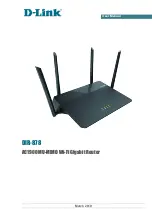
Step 1: Prepare the Site for Installation
•
Rack-Mounting Requirements on page 5
•
Moving Requirements and Guidelines for Using a Router Transport Kit on page 7
•
Tools Required to Unpack and Prepare the Router for Installation on page 9
Rack-Mounting Requirements
•
You can install the router in an open-frame rack, a four-post rack, or a cabinet.
NOTE:
The shipping and installation site must be an electrostatic discharge
(ESD)-approved area.
•
The rack rails must be spaced widely enough to accommodate the chassis’s external
dimensions: 42 in. (106.68 cm) high, 19 in. (48.26 cm) wide, and 30.90 in. (78.49 cm)
deep (measured from the front of cable manager to the rear of the chassis). An
extended cable manager extends the total depth to 36.82 in. (93.53 cm) (measured
from the front of cable manager to the rear of the chassis). See
and
In an open-frame rack, center-mounting is required to provide an even distribution of
weight for greater stability. For center-mounting, use the mounting brackets attached
to the center of the chassis for rack mounting.
•
The rack must be strong enough to support the weight of the fully configured router,
up to 742.2 lb (336.66 kg) for AC chassis, and 664.8 lb (301.55 kg) for DC chassis.
•
For the cooling system to function properly, the airflow around the chassis must be
unrestricted. Allow at least 36 in. (91.44 cm) of clearance between front-to-rear-cooled
routers. Allow 2.8 in. (7 cm) between the side of the chassis and any non-heat-producing
surface such as a wall.
•
For service personnel to remove and install hardware components, there must be
adequate space at the front and back of the router. Allow at least 36 in. (91.44 cm) in
front of the router and 36 in. (91.44 cm) behind the router.
•
The rack or cabinet must have an adequate supply of cooling air.
•
Ensure that the cabinet allows the hot exhaust air of the chassis to exit from the cabinet
without recirculating into the router.
•
The router must have the shipping covers installed to help move the router into the
rack or cabinet.
•
The router must be installed into a rack or cabinet that is secured to the building
structure.
•
The cabinet must be clear of any hardware, device, rack, or cabinet component that
obstructs the 24-U rack space from being accessed during installation.
5
Copyright © 2017, Juniper Networks, Inc.
Step 1: Prepare the Site for Installation






































